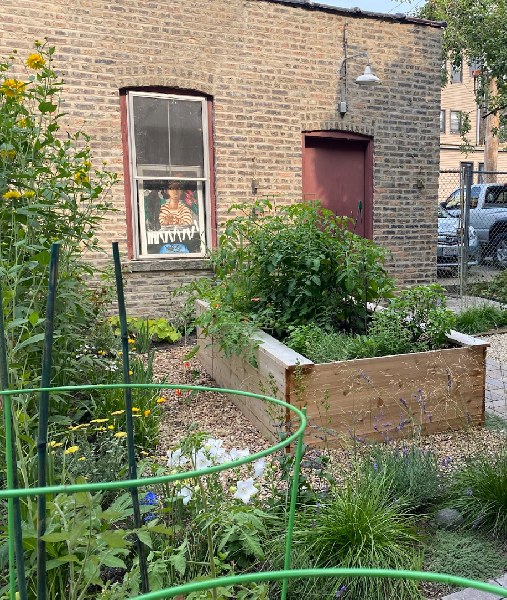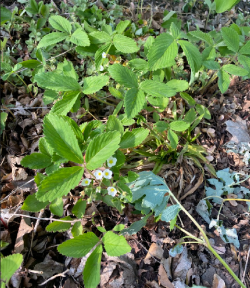Sun to Shade: Cultivating Your Own Sustainable Food Garden in Chicago
Many Chicago and North Shore homeowners believe a sunny yard is essential for a productive garden. But what if your shady spaces held untapped potential? Often overlooked, these areas are assumed suitable only for hostas and ferns. The truth is, whether you have full sun or deep shade, you can grow your own food and contribute to a more sustainable lifestyle. Let's explore how to maximize your garden's potential, from native edibles to easy-to-grow vegetables. Image: Raised Bed we installed for client
Image: Raised Bed we installed for client
 Image: Raised Bed we installed for client
Image: Raised Bed we installed for clientShade-Tolerant Native Edibles for Chicago and the North Shore:
Native plants are perfectly adapted to our local climate, including varied light conditions, meaning less work for you! Discover the delightful tastes of our region's native edibles, adding a unique twist to your culinary adventures.
Serviceberry (Amelanchier spp.): Also known as Juneberries, these shrubs or small trees produce sweet, blueberry-like fruits in early summer. They tolerate partial shade to sun and offer beautiful spring blossoms. Great for jams and pies (see yummy berries in pic to the left!).
- Elderberry (Sambucus canadensis): These shrubs produce clusters of dark berries for jams, syrups, and wines. They prefer partial shade and moist, well-drained soil. Cooked elderberries are safe, but raw berries can be toxic in some varieties. Research before eating raw.
- Wild Strawberries (Fragaria virginiana): These smaller, more flavorful cousins of cultivated strawberries happily spread as a ground cover in partial shade and prefer moist, well-drained soil.
Even if your garden's prime real estate is shaded or receives only partial sunlight, you can still enjoy a bountiful harvest. Here are some vegetables that flourish in these conditions, perfect for those cooler corners of your Midwest yards:
- Leafy Greens (Lettuce, Spinach, Kale, Arugula, Swiss Chard):
- These are the superstars of shade gardening. They actually prefer cooler temperatures and can bolt (go to seed) in intense sun.
- They tolerate partial shade (3-6 hours of sunlight) and even some dappled shade.
- Succession planting is key for a continuous harvest.
- Root Vegetables (Carrots, Beets, Radishes):
- While they prefer sun, they can handle partial shade. Expect slower growth compared to full-sun conditions, but you'll still get a delicious harvest.
- Radishes, in particular, are quick growers and do well in cooler, shaded areas.
- Brassicas (Broccoli, Cauliflower, Cabbage - Kales too!):
- These cool-season crops can tolerate partial shade, especially in the afternoon when the sun is strongest.
- They appreciate the cooler soil temperatures that shade provides.
- Herbs (Mint - plant them in pots, Parsley, Chives, Cilantro):
- Many herbs thrive in partial shade, adding fresh flavors to your meals.
- Mint, parsley, chives and cilantro in particular, prefer cooler, shady conditions.
- Peas (succession plant with Beans for the summer!):
- Peas are a wonderful cool season vegetable that handle partial shade well.
- They love to climb, so a trellis in a semi shaded area is a perfect location.

- Soil Preparation: Test for lead in soil relative to plant selection. Many native plants do need minimal amendments. Enrich your soil with compost (Compost Tea - make it yourself or utilize resources like LifeCube) to improve drainage and fertility.
- Watering: While these plants tolerate shade, they still need adequate moisture, especially during dry spells.
- Mulching: Apply a layer of mulch to retain moisture and suppress weeds.
- Observe and Adapt: Pay attention to your garden's specific conditions and adjust your planting accordingly (image of wild strawberry plant to the left).
___________________________________________________________________________________________________________________________
Eco(Fun)Fact: Nature's Little Helpers – Biological Controls for a Healthy Garden
Did you know you can harness the power of nature's own intricate web to keep your garden thriving? Biological controls offer a sustainable and often elegant way to manage pests, minimizing the need for harsh chemicals and fostering a healthier ecosystem.
- Passive Power: The Art of Attraction:
- One of the most effective and gentle methods is to create a welcoming environment for beneficial insects. Planting specific flowers that attract predatory wasps, for example, can naturally control aphid populations. These wasps are natural hunters, and by providing them with the right habitat and food sources, you create a self-regulating ecosystem.
- We saw this beautifully illustrated when we planted a native Viburnum and it wasn’t doing well. Once we planted a partner Viburnum right next to it, the plant began to flower and fruit immediately. Just like people, plants sometimes just need a partner.
Viburnum in full bloom after partner was introduced
- Active Allies: Microscopic Defenders:
- For more challenging pests, like root weevils (which can be particularly problematic in regions like Texas), active biological controls offer a powerful solution. Nematodes, microscopic roundworms, are natural predators of these pests. When applied to the soil, they seek out and eliminate root weevil larvae, effectively breaking the pest's life cycle.
- These nematodes are very specific in what they attack, and are very safe for people, pets, and the rest of the garden.
Sources:
https://extension.illinois.edu/blogs/good-growing/2020-02-20-creating-edible-landscape
https://www.marthastewart.com/vegetables-that-grow-in-shade-7563248
https://www.swansonsnursery.com/blog/shade-tolerant-vegetables-herbs
https://www.finegardening.com/project-guides/fruits-and-vegetables/the-best-biological-controls?srsltid=AfmBOorecbw8dcJ5c4zp4-IluJOWe6laSKxvaCcGqKw3DhiwVDH1tJBx




